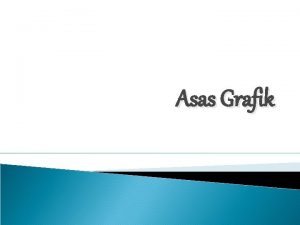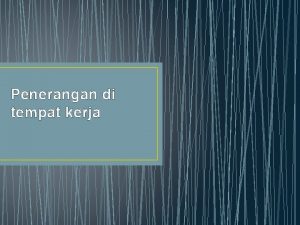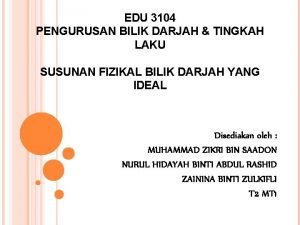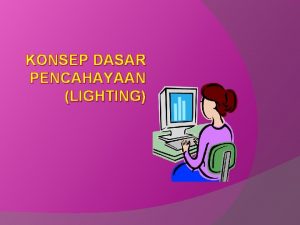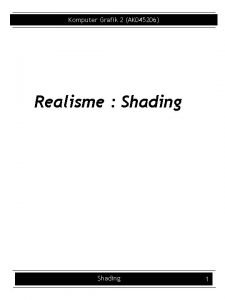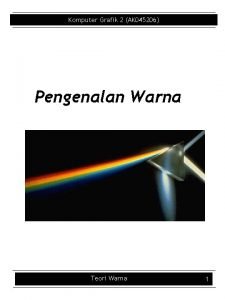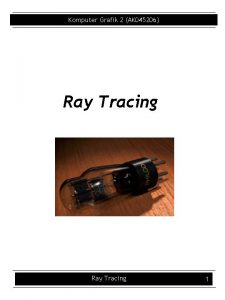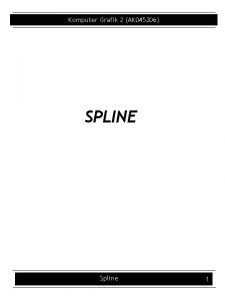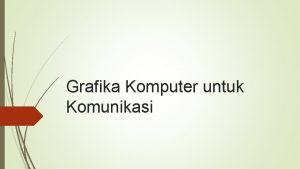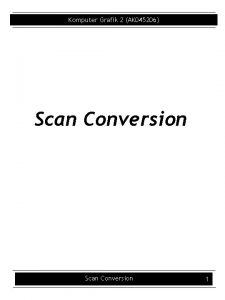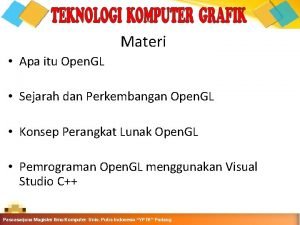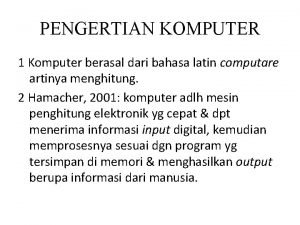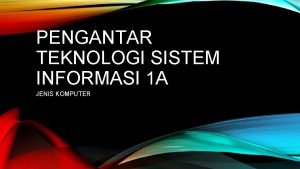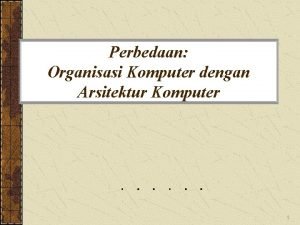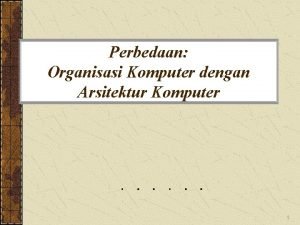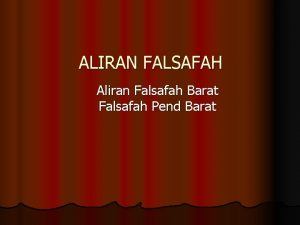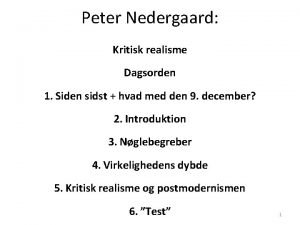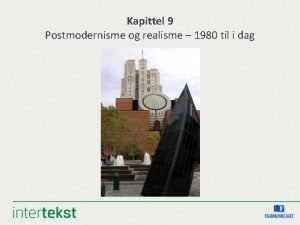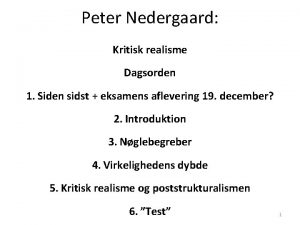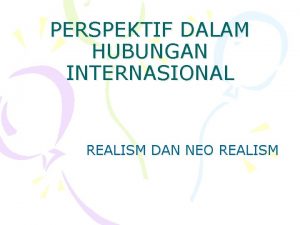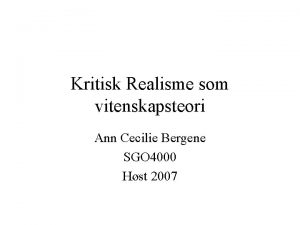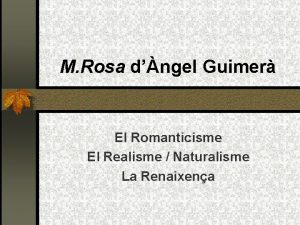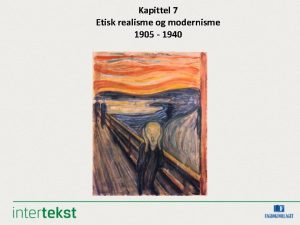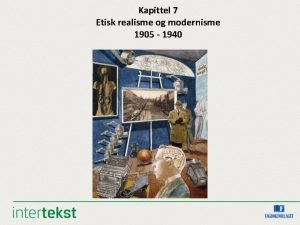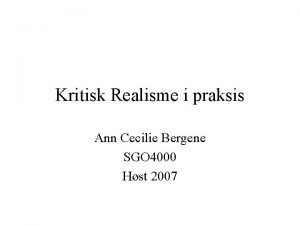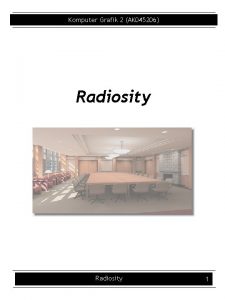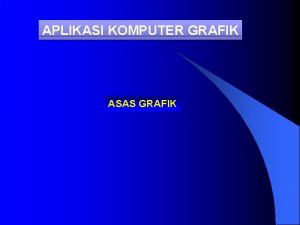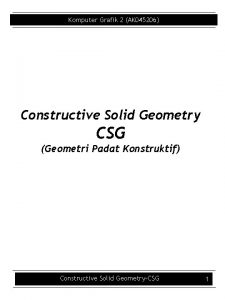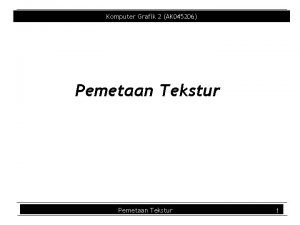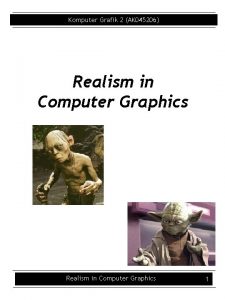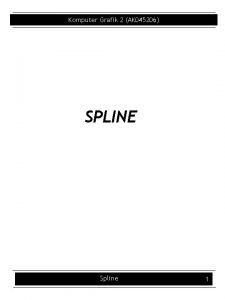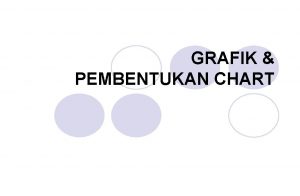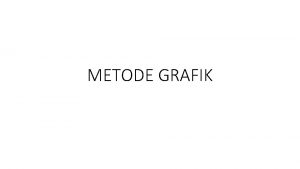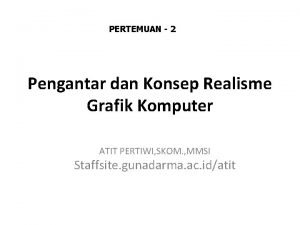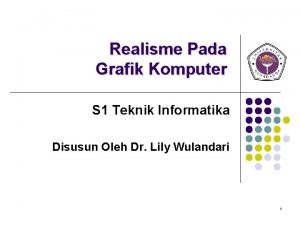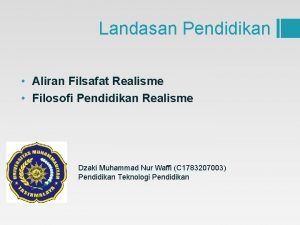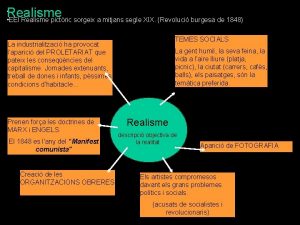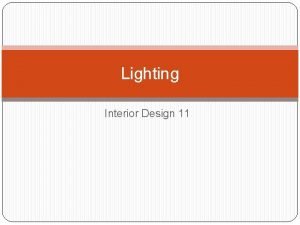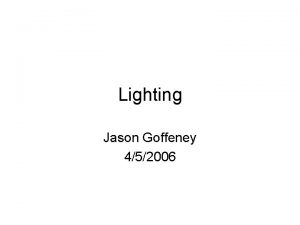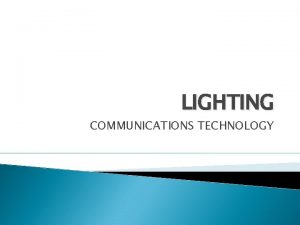Komputer Grafik 2 AK 045206 Pencahayaan Lighting Realisme


































- Slides: 34

Komputer Grafik 2 (AK 045206) Pencahayaan (Lighting) Realisme dan Pencahayaan 1

Komputer Grafik 2 (AK 045206) Outline • Pengenalan Pencahayaan • Sumber sumber Cahaya : Ambient, langsung, titik, dll • Hukum Cosinus Lambert/ difusi • Model Phong Realisme dan Pencahayaan 2

Komputer Grafik 2 (AK 045206) Introduction • Typical three step development process 1. Understand the real system – how does light work (Physics) 2. Determine what matters to us – what can we sense (Psyc) 3. Engineer a system that remains true to the portion of reality we can appreciate Realisme dan Pencahayaan 3

Komputer Grafik 2 (AK 045206) Solving the Lighting Problem – We somewhat understand the perception of light (color) – We engineered a solution to representing and generating color using computers – We need to understand the interplay of light and objects Realisme dan Pencahayaan 4

Komputer Grafik 2 (AK 045206) Optical Illusion Realisme dan Pencahayaan 5

Komputer Grafik 2 (AK 045206) Lighting • Remember, we know how to rasterize – Given a 3 D triangle and a 3 D viewpoint, we know which pixels represent the triangle • But what color should those pixels be? Realisme dan Pencahayaan 6

Komputer Grafik 2 (AK 045206) Lighting • If we’re attempting to create a realistic image, we need to simulate the lighting of the surfaces in the scene – Fundamentally simulation of physics and optics – As you’ll see, we use a lot of approximations (a. k. a perceptually based hacks) to do this simulation fast enough Realisme dan Pencahayaan 7

Komputer Grafik 2 (AK 045206) Definitions • Illumination: the transport of energy from light sources to surfaces & points – Note: includes direct and indirect illumination Images by Henrik Wann Jensen Realisme dan Pencahayaan 8

Komputer Grafik 2 (AK 045206) Definitions • Lighting: the process of computing the luminous intensity (i. e. , outgoing light) at a particular 3 D point, usually on a surface • Shading: the process of assigning colors to pixels (why the distinction? ) Realisme dan Pencahayaan 9

Komputer Grafik 2 (AK 045206) Definitions • Illumination models fall into two categories: – Empirical: simple formulations that approximate observed phenomenon – Physically based: models based on the actual physics of light interacting with matter • We mostly use empirical models in interactive graphics for simplicity • Increasingly, realistic graphics are using physically based models Realisme dan Pencahayaan 10

Komputer Grafik 2 (AK 045206) Components of Illumination • Two components of illumination: light sources and surface properties • Light sources (or emitters) – Spectrum of emittance (i. e. , color of the light) – Geometric attributes • Position • Direction • Shape – Directional attenuation – Polarization Realisme dan Pencahayaan 11

Komputer Grafik 2 (AK 045206) Components of Illumination • Surface properties – Reflectance spectrum (i. e. , color of the surface) – Subsurface reflectance – Geometric attributes • Position • Orientation • Micro structure Realisme dan Pencahayaan 12

Komputer Grafik 2 (AK 045206) Simplifications for Interactive Graphics – Only direct illumination from emitters to surfaces – Simplify geometry of emitters to trivial cases Realisme dan Pencahayaan 13

Komputer Grafik 2 (AK 045206) Ambient Light Sources • Objects not directly lit are typically still visible – e. g. , the ceiling in this room, undersides of desks • This is the result of indirect illumination from emitters, bouncing off intermediate surfaces • Too expensive to calculate (in real time), so we use a hack called an ambient light source – No spatial or directional characteristics; illuminates all surfaces equally – Amount reflected depends on surface properties Realisme dan Pencahayaan 14

Komputer Grafik 2 (AK 045206) Ambient Light Sources • For each sampled wavelength (R, G, B), the ambient light reflected from a surface depends on – The surface properties, kambient – The intensity, Iambient, of the ambient light source (constant for all points on all surfaces ) • Ireflected = kambient Iambient Realisme dan Pencahayaan 15

Komputer Grafik 2 (AK 045206) Ambient Light Sources • A scene lit only with an ambient light source: Light Position Not Important Viewer Position Not Important Surface Angle Not Important Realisme dan Pencahayaan 16

Komputer Grafik 2 (AK 045206) Directional Light Sources • For a directional light source we make simplifying assumptions – Direction is constant for all surfaces in the scene – All rays of light from the source are parallel • As if the source were infinitely far away from the surfaces in the scene • A good approximation to sunlight • The direction from a surface to the light source is important in lighting the surface Realisme dan Pencahayaan 17

Komputer Grafik 2 (AK 045206) Directional Light Sources • The same scene lit with a directional and an ambient light source Light Position Not Important Surface Angle Important Viewer Position Not Important Realisme dan Pencahayaan 18

Komputer Grafik 2 (AK 045206) Point Light Sources • A point light source emits light equally in all directions from a single point • The direction to the light from a point on a surface thus differs for different points: – So we need to calculate a normalized vector to the light source for every point we light: l p Realisme dan Pencahayaan 19

Komputer Grafik 2 (AK 045206) Point Light Sources • Using an ambient and a point light source: Light Position Important Viewer Position Important Surface Angle Important Realisme dan Pencahayaan 20

Komputer Grafik 2 (AK 045206) Other Light Sources • Spotlights are point sources whose intensity falls off directionally. – Requires color, point direction, falloff parameters – Supported by Open. GL Realisme dan Pencahayaan 21

Komputer Grafik 2 (AK 045206) Other Light Sources • Area light sources define a 2 D emissive surface (usually a disc or polygon) – Good example: fluorescent light panels – Capable of generating soft shadows (why? ) Realisme dan Pencahayaan 22

Komputer Grafik 2 (AK 045206) Lambert’s Cosine Law • Ideal diffuse surfaces reflect according to Lambert’s cosine law: The energy reflected by a small portion of a surface from a light source in a given direction is proportional to the cosine of the angle between that direction and the surface normal • These are often called Lambertian surfaces • Note that the reflected intensity is independent of the viewing direction, but does depend on the surface orientation with regard to the light source Realisme dan Pencahayaan 23

Komputer Grafik 2 (AK 045206) Lambert’s Law Realisme dan Pencahayaan 24

Komputer Grafik 2 (AK 045206) Computing Diffuse Reflection • The angle between the surface normal and the incoming light is the angle of incidence: l n • Idiffuse = kd Ilight cos • In practice we use vector arithmetic: • Idiffuse = kd Ilight (n • l) Realisme dan Pencahayaan 25

Komputer Grafik 2 (AK 045206) Diffuse Lighting Examples • We need only consider angles from 0° to 90° (Why? ) • A Lambertian sphere seen at several different lighting angles: Realisme dan Pencahayaan 26

Komputer Grafik 2 (AK 045206) Phong Lighting • The most common lighting model in computer graphics was suggested by Phong: • The nshiny term is a purely empirical constant that varies the rate of falloff • Though this model has no physical basis, it works (sort of) in practice Realisme dan Pencahayaan v 27

Komputer Grafik 2 (AK 045206) Phong Lighting: The nshiny Term • This diagram shows how the Phong reflectance term drops off with divergence of the viewing angle from the ideal reflected ray: Viewing angle – reflected angle • What does this term control, visually? Realisme dan Pencahayaan 28

Komputer Grafik 2 (AK 045206) Calculating Phong Lighting • The cos term of Phong lighting can be computed using vector arithmetic: – V is the unit vector towards the viewer – R is the ideal reflectance direction • An aside: we can efficiently calculate r? Realisme dan Pencahayaan v 29

Komputer Grafik 2 (AK 045206) Calculating The R Vector • This is illustrated below: Realisme dan Pencahayaan 30

Komputer Grafik 2 (AK 045206) Phong Examples • These spheres illustrate the Phong model as l and nshiny are varied: Realisme dan Pencahayaan 31

Komputer Grafik 2 (AK 045206) The Phong Lighting Model • Let’s combine ambient, diffuse, and specular components: • Commonly called Phong lighting – Note: once per light – Note: once per color component – Do ka, kd, and ks vary with color component? Realisme dan Pencahayaan 32

Komputer Grafik 2 (AK 045206) Phong Lighting: Intensity Plots Realisme dan Pencahayaan 33

Komputer Grafik 2 (AK 045206) Referensi • 1: , 4: Graphics. Slides 09. pdf , 5: , 8: , Global. Illumination. ppt, local. Illumination. ppt , 9: Lecture 14 • Buku Teks : 1. F. S. Hill, Jr. , COMPUTER GRAPHICS – Using Open GL, Second Edition, Prentice Hall, 2001 2. Foley, van Dam, Feiner, Hughes, and Philips, Introduction to Computer Graphics, Addison Wesley, 2000 • Lecture Notes / Slide-Presentation / Referensi lain yang diperoleh melalui internet : 3. Andries van Dam, Introduction to Computer Graphics, Slide Presentation, Brown University, 2003, (folder : brown. Uni) 4. ________, Interactive Computer Graphic, Slide Presentation, (folder : Lect_IC_AC_UK) 5. Michael CS 488/688 Mc. Cool, : Introduction to Computer Graphics, Lecture Notes, University of Waterloo, 2003 (lecturenotes. pdf) 6. ________, Computer Science 559, Slide Presentation, Wisconsin University, (folder : Lect_Wisc_EDU) 7. http: //graphics. lcs. mit. edu/classses/6. 837/F 98/Lecture 4/Slide 23. ht ml , Slide Presentation, MIT, (folder : MIT_Course. Note) 8. ________, CS 319 : Advance Topic in Computer Graphics, Slide Presentation, (folder : uiuc_cs) 9. ________, CS 445/645 : Introduction to Computer Graphics, Slide Presentation, (folder : COMP_GRAFIK) 10. Gladimir V. G. Baranoski, CS 488 : Introduction to Computer Graphics , Waterloo University 11. Prof. Peter Panfilov , http: //cse. yeditepe. edu. tr/~osertel/courses/CSE 484/index. html 12. http: //www. cl. cam. ac. uk/Teaching/1998/AGraphics/l 3 a. html Realisme dan Pencahayaan 34
 Bahan grafik maksud
Bahan grafik maksud Gambar teknik bayangan
Gambar teknik bayangan Susunan bilik darjah
Susunan bilik darjah Nilai penerangan adalah
Nilai penerangan adalah Jadual kebersihan kelas
Jadual kebersihan kelas Daya pencahayaan maksimum ruang kantor menurut sni sebesar
Daya pencahayaan maksimum ruang kantor menurut sni sebesar Konsep lighting
Konsep lighting Konsep dasar pencahayaan adalah
Konsep dasar pencahayaan adalah Komputer grafik
Komputer grafik Komputer grafik
Komputer grafik Komputer grafik
Komputer grafik Komputer grafik
Komputer grafik Komputer grafik
Komputer grafik Grafika komunikasi
Grafika komunikasi Komputer grafik
Komputer grafik Apa itu vertex
Apa itu vertex Kata komputer dari bahasa latin yang artinya
Kata komputer dari bahasa latin yang artinya Komputer untuk tujuan khusus termasuk komputer berdasarkan
Komputer untuk tujuan khusus termasuk komputer berdasarkan Perbedaan organisasi komputer dan arsitektur komputer
Perbedaan organisasi komputer dan arsitektur komputer Perbedaan arsitektur dan organisasi komputer
Perbedaan arsitektur dan organisasi komputer Perbedaan organisasi dan arsitektur komputer
Perbedaan organisasi dan arsitektur komputer Pemikiran falsafah tradisional
Pemikiran falsafah tradisional Driestuiveropera
Driestuiveropera Kritisk realisme
Kritisk realisme Postmodernisme kjennetegn
Postmodernisme kjennetegn Ontologisk realisme
Ontologisk realisme Perbedaan realisme dan neorealisme
Perbedaan realisme dan neorealisme Drama realisme
Drama realisme Eksempler på kritisk realisme
Eksempler på kritisk realisme Romanticisme i realisme
Romanticisme i realisme Etisk realisme og modernisme
Etisk realisme og modernisme Kriteria realisme adalah
Kriteria realisme adalah Romantiek schilderkunst
Romantiek schilderkunst Realisme og modernisme
Realisme og modernisme Retroduksjon
Retroduksjon
